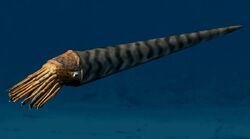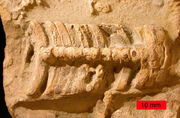| Nautiloidea Fossil range: Late Cambrian - Recent | |
|---|---|
 Orthoceras | |
| Scientific classification
| |
|
Phylum |
|
|
Class |
|
|
Subclass |
Nautiloidea |
|
Superorders, Orders |
|
Nautiloidea comprise a subclass of cephalopods, all of which possess an external shell. They flourished during the Early Paleozoic era, where they constituted the main predatory animals, and developed an extraordinary diversity of shell shapes and forms. Some 2,500 species of fossil nautiloids are known, but only a handful of species survive to the present day, within Nautilus and Allonautilus.
Diagnosis[]
Nautiloids are characterized by a phragmocone, the chambered section, in which dividing septa are bowl shaped, concave from the front and a siphuncle, the interconnecting tube that runs through the chambers, in which the septal necks point to the rear, a condition referred to as retrochoanitic. In contrast septa in ammonoids are generally flat to bowed somewhat forward, i.e. convex forward and the septal necks at least in mature individuals point to the front, a condition known as prochoantic.
Nautiloid shells may a long (longiconic) or short (breviconic), straight (orthoconic) or curved (cyrtoconic). And they may be coiled, gyroconic where whorls do not touch, evolute where whorls are in contact but all whorls are visible, or involute where only the last whorl is completely exposed.
Siphuncles may lie along the lower (ventral) margin or may be somewhere near the middle. Siphuncle interiors are highly varied from order to order.
Nautiloids are included in the Cephalopoda which also includes the Ammonoidea,belemnites and Coleoids such as octopus and squid. Cephalopods are an advanced class within the Mollusca which includes gastropods and pelecypods, also known as Bivalvia.
The most common classification of the cephalopods is the three-fold division of Bather, 1888, which divided the class into the nautiloids, ammonoids, and coleoids.
Nautiloidea is a paraphyletic taxon in that it excludes the Ammonoidea and Coleoidea to which it gave rise. It is also monophyletic in that it is derived from a single common ancestor, Plectronoceras. Cladistically nautiloids form a grade, a segment of a clade which includes forms united by well defined characters.
The ammonoidea which includes ammonites and goniatites) are extinct derivatives of the nautiloids that evolved early in the Devonian, some 400 million years ago. Also in the Devonian or Early Carboniferous, the bactritids separately gave rise to the first coleoids, in the form of early belemnoids. Hence, all cephalopods living today are descended from Paleozoic nautiloids.
Fossil record[]

Fossil nautiloid Trilacinoceras from the Ordovician of China.

Fossil orthoconic nautiloid from the Ordovician of Kentucky; an internal mold showing siphuncle and half-filled camerae, both encrusted.
Nautiloids are often found as fossils in early Palaeozoic rocks (less so in more recent strata). The shells of fossil nautiloids may be either straight (i.e., orthoconic as in Orthoceras and Rayonnoceras), curved (as in Cyrtoceras) coiled (as in Cenoceras), or rarely a hellical coil (as in Lorieroceras). Some species' shells -- especially in the late Paleozoic and early Mesozoic -- are ornamented with spines and ribs, but most have a smooth shell.
The rocks of the Ordovician period in the Baltic coast and parts of the United States contain a variety of nautiloid fossils, and specimens such as Discitoceras and Rayonnoceras may be found in the limestones of the Carboniferous period in Ireland. The marine rocks of the Jurassic period in Great Britain often yield specimens of Cenoceras, and nautiloids such as Eutrephoceras are also found in the Pierre Shale formation of the Cretaceous period in the north-central United States.
Specimens of the Ordovician nautiloid Endoceras have been recorded measuring up to 3.5 meters (13 ft) in length, and Cameroceras is (somewhat doubtfully) estimated to have reached 11 meters (36 ft). These large nautiloids must have been formidable predators of other marine animals at the time they lived.
In some localities, such as Scandinavia and Morocco, the fossils of orthoconic nautiloids accumulated in such large numbers that they form Orthoceras limestones. Although the term Orthoceras now only refers to a Baltic coast Ordovician genus, in prior times it was employed as a general name given to all straight-shelled nautiloids that lived from the Ordovician to the Triassic periods (but were most common in the early Paleozoic era.
Evolutionary history[]
The earliest known nautiloids are found in the Late Cambrian Fengsham Formation of northeastern China, with 38 named genera included four orders, the Plectronocerida, Ellesmerocerida, Protactinocerida, and Yanhecerida. The oldest genus is Plectronoceras which closely resembles the hypotheitical ancestral cephalopod. Of the eight families involved only one, the Ellesmeroceratidae survided the extinction near the end of the Cambrian, with only two known genera Clarkoceras and Ectenolites with ranges extending into the Ordovician.
The Ellesmerocerida, (Ellemeroceratidae) gave rise to the Endocerida, Actinocerida, Discosorida, Orthocerida and Tarphycerida in the Early Ordovician. In turn the Tarphycerida gave rise to the Barrandeocerida, sometimes included as a suborder, and to the Oncocerida, which gave rise to the Nautilida represented by the living Nautilus and Allonautilus. The Early and Middle Ordovician nautiloid diversification was perhaps due to new ecological niches made available by the extinction of anomalocarids at the end of the Cambrian. Nautiloids remained at the height of their range of adaptations and variety of forms throughout the Ordovician, Silurian, and Devonian periods, with various straight, curved and coiled shell forms coexisting at the same time. Several of the early orders became extinct over that interval, but others rose to prominence.
Nautiloids began to decline in the Devonian, perhaps due to competition with their descendants and relatives the Ammonoids and Coleoids, with only the Nautilida holding their own (and indeed increasing in diversity). Their shells became increasingly tightly coiled, while both numbers and variety of non-Nautilid species continued to decrease throughout the Carboniferous and Permian.
The massive extinctions at the end of the Permian were less damaging to nautiloids than to other taxa and a few groups survived into the early Mesozoic, including pseudorthocerids, bactritids, nautilids and possibly orthocerids. The last straight-shelled forms were long thought to have disappeared at the end of the Triassic, but a possible orthocerid has been found in Cretaceous rocks. Apart from that exception, only a single nautiloid suborder, the Nautilina, continued throughout the Mesozoic, where they co-existed quite happily with their more specialised ammonoid cousins. Most of these forms differed only slightly from the modern nautilus. They had a brief resurgence in the early Tertiary (perhaps filling the niches vacated by the ammonoids in the end Cretaceous extinction), and maintained a worldwide distribution up until the middle of the Cenozoic Era. With the global cooling of the Miocene and Pliocene, their geographic distribution shrank and these hardy and long-lived animals declined in diversity again. Today there are only six living species, all belonging to two genera, Nautilus (the pearly nautilus), and Allonautilus.
References[]
- Treatise on Invertebrate Paleontology, Part K. R.C. Moore and Curt Teichert, Eds. Geological Society of America and University of Kansas Press. 1964
- Teichert, C. 1988. "Main Features of Cephalopod Evolution", in The Mollusca vol.12, Paleontology and Neontology of Cephalopods, ed. by M.R. Clarke & E.R. Trueman, Academic Press, Harcourt Brace Jovanovich,
- Doguzhaeva, Larisa. 1994 An Early Cretaceous orthocerid cephalopod from north-western Caucasus. Palaeontology 37(4): 889-899.
- Mary Wade. Nautiloids and their descendants: cephalopod classification in 1986.
- Chen Jun-yuan & Curt Teichert. Cambrian cephalopods. Geology v 11, p. 647-650. November 1983
External links[]
See also[]
- Ammonoidea
- Belemnoidea
- Lituites